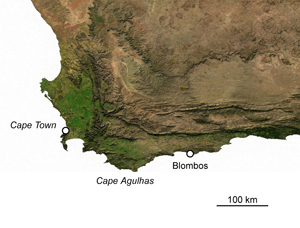
WASHINGTON (AFP) – Two shells containing a primitive paint mixture have been uncovered in South Africa, revealing what researchers believe may be the remnants of a 100,000 year old art studio.
The abalone shells held a paste containing ochre, an earthy iron ore offering yellow or red hues, which may have been used for painting or body decoration, said the study in the journal Science.
The shells were found at Blombos Cave in Cape Town near other tools, which suggested the users were scraping off ochre flakes and mixing them with other compounds to form a liquid paint.
Stone Age artists likely rubbed pieces of ochre on quartzite slabs to make a fine red powder. Any chips of ochre were probably crushed with quartz hammers and mixed with hot crushed animal bone, charcoal, stone chips and some liquid.
The concoction was then transferred to the shells and “gently stirred,”said the study led by Christopher Henshilwood from the Institute for Human Evolution at the University of the Witwatersrand, Johannesburg.
“A bone was probably used to stir the mixture and to transfer some of the mixture out of the shell,” said the study.
The discovery suggests that humans of the era understood some basic chemistry and were able to plan ahead to store the paint for future use, whether ceremonial, decorative or protective.
“Ochre may have been applied with symbolic intent as decoration on bodies and clothing during the Middle Stone Age,” said Henshilwood. “This discovery represents an important benchmark in the evolution of complex human cognition in that it shows that humans had the conceptual ability to source, combine and store substances that were then possibly used to enhance their social practices.”
Scientists were able to date the quartz sediments in which the shells were found to 100,000 years ago using a process called optically stimulated luminescence dating (OSL).
The absence of other archeological remains in the area suggests the “site was used primarily as a workshop and was abandoned shortly after the compounds were made,” said the study. “Sand then blew into the cave from the outside, encapsulating the toolkits.”
The two specimens will be on display at the Iziko Museum in Cape Town beginning on October 14.
# # #

